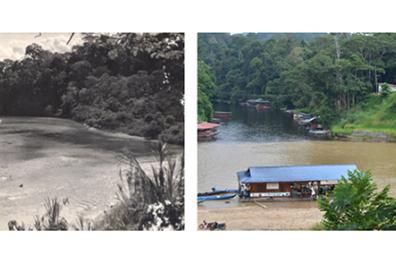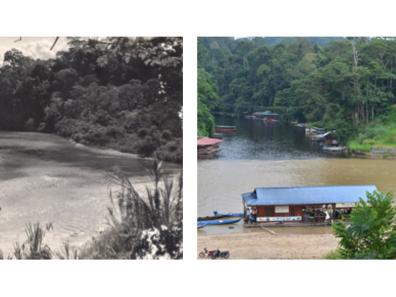History of the human-wildlife relationship in Southeast Asia

For two consecutive years, the "Social History of Southeast Asia" master's and doctoral seminar run jointly by Inalco, Université Paris-Denis-Diderot and EHESS has explored themes relating to the environmental history of Southeast Asia[1]. Exchanges with environmental historians, such as Grégory Quenet or Greg Bangkoff, and ecologist Pierre-Michel Forget provided an opportunity to refine research avenues around wildlife and forest conservation policies in Southeast Asia.
A three-month stay in 2016 with Ahimsa Campos-Arceiz's team on the Malaysian campus of the University of Nottingham, funded by the CNRS InSHS (Institut des sciences humaines et sociales) International Mobility Support scheme, provided access to Malaysia's national archives, the Malaysian Nature Society, and key conservation witnesses, activists, officials and wildlife department rangers. Unlike other countries in the region, such as Cambodia, Malaysia has succeeded in establishing a relatively effective conservation policy. Its origins date back to the colonial period.
Under the impetus of a few colonialists, such as the great hunting enthusiast Theodore Hubback, the states of the Malay Peninsula adopted wildlife protection legislation, created parks and reserves - notably King George V National Park, now Taman Negara - and set up a wildlife protection department. After the war, the Malayan Nature Society (MNS) found itself at the heart of networks linking conservation activists, scientists, international experts, wildlife department officers and political decision-makers. Independent Malaysia (1957) continued the programs conceived under British rule and developed its own conservation policies. In Cambodia, on the other hand, the French colonial power merely regulated hunting.

The research projects being conducted today aim to place these case studies in a regional dimension. This is made possible by the USPC-National University of Singapore project "Governing Southeast Asian Natures" (2018-2020), which brings together historians, researchers in the social sciences and humanities and environmental scientists to produce an environmental history of Southeast Asia. Two workshops bringing together European, Southeast Asian and North American researchers have been organized in Singapore in November 2018 and at Inalco in May 2019. Several collaborative projects on the environmental history of the Southeast Asian region have emerged from them.
In addition, the dynamics observed in Southeast Asia on the patrimonialization of nature are part of a broader framework that is notably interrogated by the ANR PANSER project (PAtrimoine Naturel aux Suds: une histoire globale à Échelle Réduite, 2018-2021) led by Guillaume Blanc from the University of Rennes 2. Using different examples in Africa, the Indian Ocean and Asia, and following key players in conservation, project members seek to grasp the mechanisms, policies and networks that led to the establishment of natural areas to be protected in the South in the 20th century, and to question their relevance.
In Southeast Asia, the research carried out within this framework shows that the establishment of reserves and parks in Malaysia, far from being the dictates of colonial authority, were the result of intense negotiations between different currents within the British administration, local populations, sultans and their courts. Conservationists were forced to make concessions, which facilitated the maintenance of these protected areas after independence and, in the long term, reinforced their effectiveness in protecting wildlife. In Cambodia, it wasn't until the United Nations Transitional Authority (UNTAC) and the intervention of international NGOs and experts that a series of national parks and wildlife sanctuaries were created in 1993. The effectiveness of these externally imposed conservation tools is still fragile.
Mathieu Guérin
Maître de conférences HDR en histoire de l'Asie du Sud-Est
Member of the Centre Asie du Sud-Est (CASE), UMR 8170 (EHESS-CNRS-INALCO) on the environmental history of Southeast Asia and the social history of Cambodia in colonial times
____________
[1] "Men and forests in Southeast Asia, practices and representations of a privileged relationship" (2016-2017), then "The unexpected in history, catastrophes and cataclysms in Southeast Asia" (2017-2018).
International workshops
- Afro-Asian Nature Conservation Areas. Towards a Small-Scale Global History, University of Rennes, forthcoming (February 2021).
-The Second "Governing Southeast Asian Natures Workshop", Institut national des langues et civilisations orientales, Paris, May 22-23, 2019.
- The First "Governing Southeast Asian Natures Workshop", National University of Singapore, Singapore, November 7-8, 2018.
Publications
Editing books or journal issues
- Mathieu Guérin (ed.), dossier: "Sociétés humaines et forêts en Asie du Sud-Est", Péninsule, n°75, 2017, pp. 7-130.
- Mathieu Guérin (ed.), special issue, Malayan Nature Journal, December 2017.
Articles in refereed journals
- Guérin, Mathieu, "Protecting the forest and its wildlife from natives in British Malaya", Péninsule, n°75, 2017, p. 37-71.
- Guérin, Mathieu, Lim, Teckwyn, Tan, Ange S.L., Campos-Arceiz, Ahimsa, "A favourable shift towards public acceptance of wildlife conservation in Peninsular Malaysia: comparing the findings of the Wild Life Commission of Malaya (1932) with a recent survey of attitudes in Kuala Lumpur and Taiping, Perak", Malayan Nature Journal, December 2017, p. 21-31.
- Guérin, Mathieu, "Bridging British Malaya and Malaysia. The Malayan Nature Society and Nature Conservation, 1940-1978", Malayan Nature Journal, December 2017, p. 1-19.
- Guérin, Mathieu, "Conserving wildlife on the Malay Peninsula, from British Malaya to independent Malaysia", VertigO, la revue électronique en sciences de l'environnement, vol. 17, n°1, May 2017.
Scientific Communications
- Guérin, Mathieu, "Access to Forest Resources and Effectiveness of Protected Areas in Malaysia. A Historical Perspective on the National Park and the Krau Reserve since the Colonial Era", Association for Tropical Biology and Conservation congress, Kuching, July 3, 2018.
- Guérin, Mathieu, "Colonisation and Wildlife Conservation in Cambodia and Malaysia", international workshop Destruction and Conservation in Debate: Brazil's environmental history in a global perspective, École des hautes études en sciences sociales, Paris, October 14, 2016.
- Guérin, Mathieu, "Pioneering Wildlife Conservation in Malaysia - a Historian's Perspective", Mindset Public Talks, Nottingham University Malaysia Campus, Kuala Lumpur, September 21, 2016.
- Guérin, Mathieu, "Maîtriser le sauvage: l'introduction du concept d'animal nuisible en Indochine française et en Malaya britannique", Centre Asie du Sud-Est seminar, Paris, December 4, 2014.